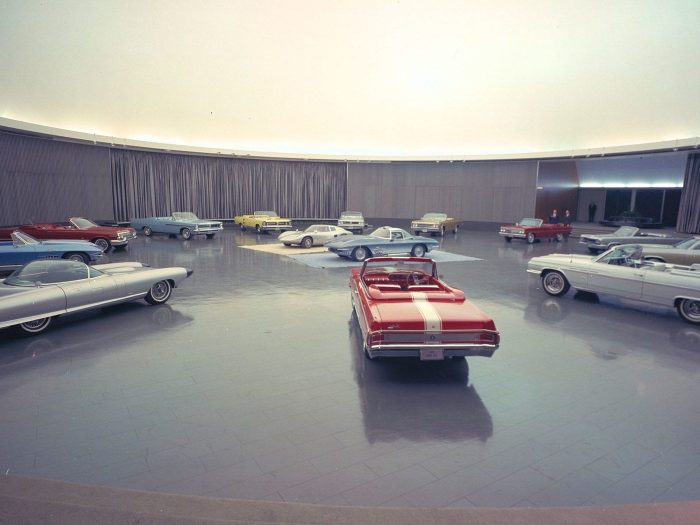In 1996, he was declared “the greatest living graphic designer”—it was yet another ‘feather in the cap’ for Paul Rand, and one of many during a long and colorful career that would make any present day designer envious. But more so when the acclamation comes from a visionary like Steve Jobs. In fact, it was Paul Rand’s dedication to treating design as a function of business that helped Steve Jobs’ Apple to become the design-leading powerhouse that it is today.
In 1986, Rand was hired to create a logo for Jobs, reportedly for a fee of $100,000. But long before that—back in the 1950s—he had already begun to pave the way for design systems, and the notion of corporate identity.
Many consider Rand to be the father of modern graphic design—the man who introduced the idea that commercial art could, and should, have both a strong visual appeal and an important functional role in the world of modern business.
In any case, his influence on design, starting in the 1930s, forever changed the world of modern business.
This is how he did it.
A Young Start
Rand was born Peretz Rosenbaum, in Brooklyn, New York, in 1914. As a young boy, he exercised his creativity by painting signs for his father’s grocery store but his curiosity, and his developing interest in art, soon expanded far beyond grocery signs. His traditional Orthodox Jewish upbringing forbade the creation of certain images that could be interpreted as idolatry. He persisted, however, and found influence in European design magazines while further developing his own style by sketching in secret.
In his late teens, despite his father’s wishes, Rand attended school at the Pratt Institute and the Parsons School of Design in New York City. Although these institutions were (and still are) leaders in design education in the US, Rand was dissatisfied with their idealisms and approach to modern design. Instead, he decided to educate himself by focusing on developments in communication arts that were coming out of Europe at the time.
“European designers at that time were ideologically aligned to some sort of an idea,” explains Alexander Tochilovsky, design curator at The Herb Lubalin Study Center of Design & Typography at The Cooper Union in New York City.
“They had an ideal in mind, like the Bauhaus, and the Russian constructivists. There’s a philosophical underpinning to the work they were doing, so the formalism was an extension of the stuff they were exploring. It was new, it was effective, and Paul Rand and other American designers saw that it was different; it was nice, it was changed visually. It was not old-fashioned; it was very progressive. It was modern. It fit what was happening in the arts. It was revolutionary.”
Rand was one of the first American graphic designers to apply European idealism to American consumerism. In the early 1930s. he quickly made a name for himself, designing product spreads and magazine covers—many of which employed his particularly modern method of grabbing a reader’s attention: putting eye-grabbing visuals first and explanatory copy second.
“As a designer, Rand had a different skill set from that of advertising copywriters,” explains Tochilovsky. “He could see the bigger picture because he really was putting the whole thing together visually. The communication of advertising is first visual and then linguistic or verbal. You see it first, and then you read it. So if it doesn’t make you interested in seeing it, or if you don’t have the desire to keep looking at it, you’re not going to get to the level of the text. It was common sense to him, but nobody else was really doing it.”
By 1935, Rand was already considered to be one of the most forward-thinking designers of his generation. But, at the age of 21, he had to take on his first serious project in brand identity—his own.
Many innovative businesses today accept—and even celebrate—designers who have different origins, backgrounds, and perspectives. Acceptance was not the reality for an Orthodox Jew living in post-World War I America, however. As a result, Rand legally changed his name from Peretz Rosenbaum to ‘Paul Rand’—a name chosen partly for its potential for a well-balanced graphical symbol when he signed his work.
In 1937, aged 23, Rand went from creating magazine spreads on a freelance basis, to the distinguished position of Art Director at Esquire Magazine. At the age where today’s designers are fresh out of design school and just getting traction within the industry, Rand was already at the top of his field—effectively carrying a torch into new territory, and leading the way into the future of graphic design.
The Ad Man
Like many creatives at the time, Rand gradually moved into New York’s cutthroat world of advertising on Madison Avenue. In 1941, as a 27-year-old with nearly a half-decade of art direction experience behind him, he was formally offered the role of Chief Art Director at the newly-formed ad agency William H. Weintraub & Co.
With a penchant for strong and balanced visual communication, Rand took an approach to advertising that was radically different from anything that had gone before. Rather than shrouding an advertisement in copy and placing it with a generic image, he chose to celebrate white space and treat each advertisement as its own unique piece of art—much like his magazine covers.
“Rand truly understood that the aesthetic draws attention,” says Tochilovsky. “It allows for information to come through in an interesting way that is not bogged down by overloaded and overused imagery. That’s what was happening in advertising, left and right–cliché after cliché. It doesn’t even matter what the text is. When the visuals are constantly saturated with the aspirational lifestyle thing, companies have a hard time cutting through the noise. He saw the potential of the new aesthetic to cut through all that. It was more effective in terms of getting the message across; to them, it was a no-brainer. It was just so much better than what was being done previously.”
By bringing visual intelligence and wit to advertising, Rand effectively helped establish the importance of the Art Director’s role as we know it today. His influence spread far and wide, and it was only a matter of time before the world’s leading corporations picked up his idealism and his understanding of the role of design as a functional tool in modern business.
Good Design is Good Business
By the 1950s, International Business Machines Corporation (IBM) had established itself as one of the leading data processing companies in the world. IBM’s president, Thomas Watson Jr., was one of the earliest believers in the role of design as a functional tool in the modern business landscape. He ordered a complete overhaul of IBM’s graphic communications system and quite specifically, chose Paul Rand to do it.
Over the next decade, Rand created what was perhaps the first design system for a corporate identity.
Starting with the redesign of the IBM logo—a years-long process of strategic incremental changes—Rand created a central design language that informed all applications of the IBM identity across the entire company. By incorporating horizontal stripes into the logotype, he was both able to unify the letter and give the otherwise monolithic company a more ‘human’ dimension. The result was to be the basis for a new graphic standards system, implemented in everything from letterheads and package designs to showroom interiors and company offices.
The design system was so thorough, in fact, that it would later influence Unimark’s 1970 New York City Transit Authority Graphics Standards Manual for the New York City subway system, and Danne & Blackburn’s 1975 National Aeronautics and Space Administration Graphics Standards Manual for NASA.
Today we take for granted the importance of corporate identity and brand cohesiveness. Before Rand’s overhaul of the IBM logo and the company’s entire design system, the concept was nearly non-existent. But it wasn’t just Rand’s skill in design that led to his success in implementing a modern design system; it was also in his ability to sell non-designers on the functional role that design plays in the corporate identity. In many ways, it was Rand’s ability to communicate the importance of design in presentations that opened up the role of the graphic designer, from the 1960s until today.
“The fact that he could meet with the CEOs of these companies, and convince them about good design, had an insane impact on the rest of the corporate world and the emergence of the field of graphic design,” explains Tochilovsky. “Executives from other corporations were looking at IBM and saying, ‘Those graphic designers did that. We need a hotshot designer to do the same thing for us, because, look, it looks good.’ It was drawing attention. People saw the value that that had. It definitely redefined things. It also made it a lot easier for designers to do what they did. I think, in that canon, Rand is right up front.”
With the success of IBM’s design overhaul, it wasn’t long before other major corporate clients were knocking on Rand’s door. By the mid-1960s, using a refined graphic style stripped of unnecessary ornamentation, he revamped the corporate identities of Westinghouse, UPS, ABC, and a slew of other rising corporations. Many of those designs were so timeless, in fact, that they still exist in some form or another as he first interpreted them in the 1960s.
“Most of these logos are so on point,” says Tochilovsky. “Even with various updates over the years, many of them still retain his original touch. The recent upgrade to the UPS logo, for example, still retains some of the quality that he injected into it, like the brown color. That’s an insane move to make, to make it brown. It’s the most unsophisticated move, but it’s totally perfect. It redefined the brand, and still defines the brand. Shipping, brown… you know it’s UPS. That level of precision is pretty spot on, and really gutsy, too. That’s going out on a limb to say: ‘Let’s not make it blue, let’s not make it something that’s a neutral thing. No, we’re going to make it defining, but it’s going to be brown.’”
Ultimately, it didn’t really matter what, or for whom, Rand was designing. His ability to exercise simplicity and restraint, and to arrive at extremely effective logo designs and design systems became the new standard for making corporations more personable. Today, it’s an absolute necessity.
A Living Legend
While many designers tend to fade out and lose touch in their later years, Rand continued to become ever more popular as the years went on—commanding a rumored $100,000 per single logo design during the 1980s and early 1990s. Among the most notable of his clients during this time was Steve Jobs, founder of Apple Computer.
In 1985, after resigning from the company he founded (but later returned to), Jobs went on to start NeXT Computer, in an effort to corner the educational sector with a revolutionary workstation. The field of graphic designers had grown substantially by this time but, to develop the identity of his new company, Jobs wanted one designer, and one designer only: Paul Rand.
“(Paul Rand) is one of the most professional people I’ve ever worked with,” explains Jobs in a 1993 interview. “I asked him if he would come up with a few options. He said, ‘No, I will solve the problem for you, and you will pay me. You don’t have to use the solution; if you want options, go talk to other people. But I’ll solve the problem for you.’ It was very refreshing to work with somebody like that.”
Whether by accident or through the workings of a higher being, the meeting between these two legends had a massive impact on the future of design as we know it today, and played a part in the story of one of the world’s most valuable companies, so deeply rooted in cohesive brand identity and user interactions.
But perhaps more important is Rand’s influence on the future of graphic design: the future of visual harmony.
“Other people came before him, at the turn of the century, for sure,” adds Tochilovsky. “But Paul Rand was one of the first to define everything that came after. To me, he is the pioneering, defining, quintessential American graphic designer. I think, without him, a lot of this other work would have happened but would have been harder. He had a huge impact on the role of design in industry—something that significantly paved the way for all graphic designers today.”



